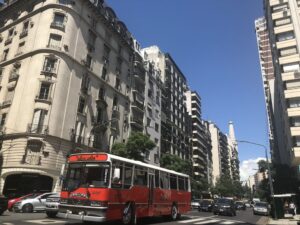An Insider Guide to Transportation in Buenos Aires


I was already running late, having slept through my alarm, and had about 25 minutes to get to class. Back on my home university’s campus this wouldn’t have been a problem. In the U.S. I attend a small college and every class is within reasonable walking distance. In contrast, I have found that attending class in a city as big as Buenos Aires requires I allot ample time to commute from place to place. I knew I could get to the class I was rushing to in about 20 minutes if I took the subway so I walked down the street to my usual train stop as quickly as I could manage in the busy morning foot traffic. As I approached the steps I saw that the entrance had been gated closed and the electric sign above that usually spelled out the schedule read: “Cerrado para el paro.” Translation: “Closed for the strike.” Great.
Buenos Aires is massive and IFSA students live in barrios all over the capital. You are inevitably commuting via public transportation or walking every single day, and in a massive city teeming with daily political protests, worker strikes, and general population density, there are more efficient and enjoyable ways to do so than others.
For those whose first time it is living in a huge city you might find that these long and sometimes hectic commutes can be exhausting. Depending on the time of day, the mode of transportation you choose could be delayed, overflowing with people (literally), or closed due to large political demonstrations. While some of this cannot be avoided entirely it is helpful to know what modes of transportation are like at what times of day and which options are best for certain kinds of travel.

Modes of Transportation
The bus: Buses are one of the most popular methods of transportation, not just in the city but in Argentina as a whole. There are different types of buses for different types of travel. You may know the Spanish word for bus as “autobus,” but in Buenos Aires they refer to the commuter buses as “colectivos.” These arrive frequently but travel slowly through the congested city traffic and while they’re generally more expensive than the subway, they seem to be the travel method of choice for many Argentines. Buses that travel longer distances across the country are referred to as “omnibus” or “micros” and are comfortable and popular.
The train/subway: The Buenos Aires subway system is called “el subte.” While they arrive less frequently than the colectivos, they travel much faster, assuming you can get on the first one that arrives. It can get so crowded during rush hours that those waiting on the platform cannot physically fit into any of the train cars. I quickly learned that in certain hours I may have to wait for more than one train to come by. The subte is also cheap, at just $0.30 USD per ride. Trains that travel longer distances into the nearby provinces are also accessible from the subte lines.
Walking: This is my personal favorite way to get around Buenos Aires. As long as you’re careful of traffic, it’s an easy city to walk long distances in. Not only is walking free of charge but it’s a great way to immerse yourself in the city, familiarize yourself with the different streets and neighborhoods, and get some exercise.
Taxis: These are reliable and safe when officially marked. Although they are not horribly expensive the traffic in the city gets very congested and it often takes just as long as taking a colectivo.
Your Sube Card

Your Sube Card is a rechargeable card that you need in order to use any subtes or colectivos. Once you buy one for $25 Argentina pesos ($1.00 USD) you can recharge it at most kioskos (corner stores marked with signs) or at the subte stations with cash.
General Travel Tips
When the colectivos or subte get packed during rush hour don’t be shy about pushing a little to fit onto the vehicle. Locals will push their way on, and if you don’t join in you’re sure to get left behind! What’s more, when walking watch out for other pedestrians and the pigeons because neither will move out of your path.
Safety Tips
The public transportation in Buenos Aires is relatively safe, but there are definitely some things to be aware of! First and foremost, it’s very common for people to attempt to steal money or phones out of bags and backpacks so it’s recommended you wear any bag on the front of your body. You may think it looks silly but you’re sure to see locals practicing this regularly. If you want to listen to music on your long walks or commutes make sure your phone is in a front, very secure, pocket.
Furthermore, when traveling at nighttime IFSA-Butler recommends taking the colectivo. If you want to use a taxi they suggest that you call a radio taxi so that the taxi company has record of your ride. Walking is also an option in neighborhoods like Palermo and Recoleta but again, IFSA-Butler stresses that you make sure someone knows where you are and when you get home. I’ve yet to feel unsafe while traveling through the city, be it day or night, but as with all big cities all over the world, it is best to be aware of your surroundings and practice caution at all hours of the day.
Alex Kenoian was an International Relations & Computer Science double major at Mount Holyoke College and studied abroad with IFSA at the Argentine Universities Program in Buenos Aires in Spring 2018. She served as an International Correspondent for IFSA through the Work-To-Study Program.